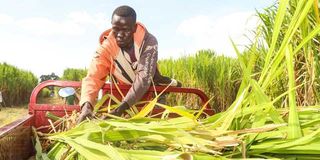Chinese ‘magic grass’ can help to eradicate poverty

A farmhand harvests Juncao grass at J and V farm at Kampi ya Moto in Nakuru.
As home to the largest number of developing countries, Africa is still beset by many development challenges, key among them widespread poverty. Africa’s aggregate economic growth is projected to increase in the next two years, the momentum will have little impact on poverty reduction in the continent, says the World Bank.
It is for this reason that Africa has sought to put poverty alleviation on the centre stage in its development cooperation with China. During the 8th ministerial conference on the Forum on China Africa Cooperation (FOCAC) in 2021, both parties committed to building a poverty reduction coalition, bringing together businesses, academia and social organisations. In 2022, the Africa-China Alliance on Poverty Alleviation was launched to facilitate targeted cooperation towards reduction of poverty, rural transformation and consolidation of sustainable development.
800 million people
Having moved over 800 million people out of poverty in just three decades, China has become a yardstick for many developing countries in poverty eradication. It became, in 2020, the first developing country to eliminate extreme poverty—and this ahead of the United Nations’ 2030 deadline! Under the auspices of FOCAC, Beijing has continued to share its expertise, resources and technology with African counterparts.
By shifting the focus on small projects with short turnaround times and strong impacts on respective populations, Africa can adopt some Chinese technologies to support its agricultural sector.
Agriculture is the backbone of Kenya’s economy, employing over 70 per cent of the rural population and contributing 33 per cent to the gross domestic product.
One product from China that could turn around agricultural productivity and job and wealth creation, is the Juncao grass. The “magic grass” grows easily, matures faster than many others and can be put to multiple uses across the agricultural value chain.
Livestock farmers
Many Kenyan livestock farmers struggle with sustainable supply of quality feeds, a situation worsened by climate change, which has wiped off pasture from traditional grazing fields.
Juncao can be harvested more than five times a year with annual yields of up to 180 tonnes per acre, which can comfortably support 20 cows or 200 goats. With crude protein of 18.6 per cent compared to the 10.8 per cent of the conventional napier grass, Juncao not only reduces the cost of feeds, but also enhances productivity in animal products such as beef and milk.
Besides its use in animal feeds, Juncao has also proven very effective in rolling back desertification by acting as carbon sinks while conserving the soil. Growing it in large scale will strengthen Kenya’s food security and create jobs, especially for young Kenyans.
Now available in Kenya, this grass offers local farmers and entrepreneurs an opportunity to upgrade the country’s livestock sector support, also spurring the line processing and manufacturing sectors.
Dr Adhere, PhD, is a scholar of international relations with a focus on China-Africa development cooperation. @Cavinceworld





